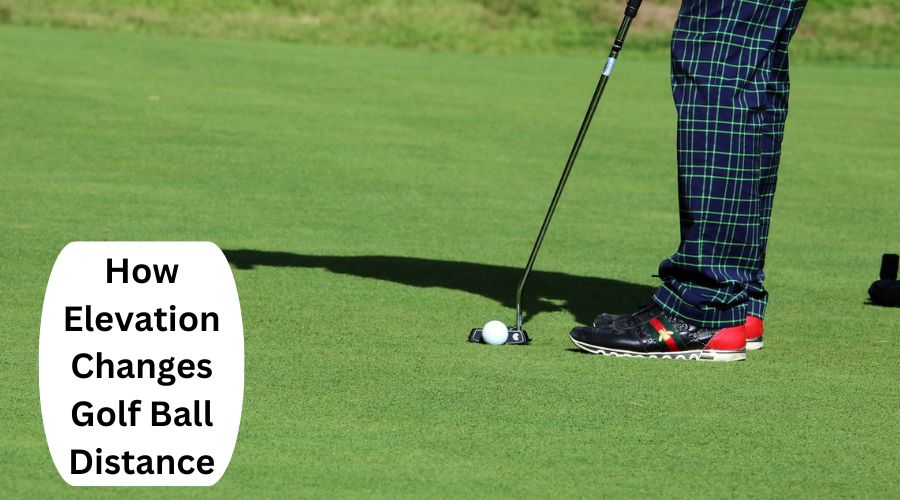Elevation affects golf ball distance as higher elevations with colder temperatures tend to result in shorter distances, while increased altitude at higher elevations directly relates to longer golf ball distance due to thinner air. The higher the elevation, the thinner the air which means less resistance on the ball allowing it to travel further.
However, the colder temperatures at higher elevations can cause the golf ball and club to be colder resulting in less distance. It is important for golfers to adjust their game accordingly when playing at different elevations to maintain accuracy and consistency.
We will explore how elevation impacts golf ball distance and provide tips for golfers to adjust their game when playing at different elevations.
Contents
Introduction To Elevation Effects
Elevation plays a crucial role in the game of golf, impacting various factors that affect the distance a golf ball can travel. Understanding the effects of elevation is essential for golfers to make accurate calculations and adjustments to their game. In this article, we will explore the impact of elevation on golf ball dynamics, as well as the role of atmospheric conditions, providing valuable insights for golfers looking to improve their performance at different elevations.
Impact On Golf Ball Dynamics
When it comes to golf ball dynamics, elevation significantly affects the distance and trajectory of a golf ball. At higher elevations, the reduced air density causes the golf ball to experience less resistance, resulting in a longer carry and overall distance. Conversely, at lower elevations, denser air creates more drag on the golf ball, leading to shorter distances. The change in elevation directly influences the ball’s flight path, requiring golfers to make precise adjustments to their shots based on the specific elevation of the course.
Role Of Atmospheric Conditions
Atmospheric conditions, including temperature and humidity, further compound the impact of elevation on golf ball distance. In higher elevations with colder temperatures, golf balls tend to travel a lower distance due to the colder club and ball affecting performance. Additionally, air density can also affect lift, altering the ball’s trajectory and landing angle. Understanding the interplay between elevation and atmospheric conditions is essential for golfers to adapt their game and optimize their shots accordingly.
Physics Behind The Flight
Golf ball distance is influenced by elevation due to changes in air density and aerodynamics. Understanding the
Air Density
is crucial in comprehending how elevation affects the flight of the ball.Understanding Air Density
Air density decreases as altitude increases, impacting the performance of the golf ball in the air.
How Lift And Drag Change With Altitude
At higher altitudes, the reduced air density affects lift and drag forces, leading to variations in the ball’s trajectory and distance.
Practical Insights From Golf Professionals
Experiences At Different Elevations
Golf professionals have observed significant variations in golf ball distance at different elevations. At higher elevations, the thinner air results in decreased air resistance, allowing the golf ball to travel farther. Conversely, at lower elevations, denser air creates more resistance, leading to shorter distances. These observations have prompted golf professionals to develop strategies to adapt to varying elevations.
Adjustments In Playing Strategy
Golf professionals emphasize the importance of adjusting playing strategies to account for elevation changes. When playing at higher elevations, they recommend using a club with less loft to compensate for the reduced air density, ensuring the ball reaches the desired trajectory. Additionally, professionals advise golfers to factor in the impact of elevation on ball carry and roll when planning their shots, enabling them to make informed decisions based on the specific elevation of the course.
Equipment Adjustments
To maximize golf ball distance, make equipment adjustments for elevation changes. At higher altitudes, use a hybrid club to increase ball carry by launching it higher, compensating for thinner air. Adapt your trajectory for optimal performance on the course.
Choosing The Right Golf Clubs
Elevated golf courses require careful consideration when selecting the right golf clubs. At higher altitudes, the air is thinner, resulting in reduced air resistance, which can lead to increased ball flight. To maximize distance, it’s essential to choose clubs that provide the necessary loft and carry for the elevation. Opt for clubs with higher lofts, such as drivers and fairway woods, to help launch the ball at the desired trajectory and achieve the optimal distance.
Ball Selection For Elevated Courses
When playing at elevated courses, the selection of the right golf ball is crucial. Opt for golf balls that offer lower compression, as they tend to perform better at higher altitudes. Lower compression balls can help maximize the distance and control, compensating for the impact of thinner air. Additionally, consider using golf balls designed for higher elevation to further enhance performance, ensuring an optimal and consistent ball flight.
Case Studies: Golf Courses At High Altitudes
When it comes to golfing at high altitudes, the impact on ball distance is substantial. The reduced air density at higher elevations results in decreased resistance to the ball’s flight, allowing it to travel farther. Additionally, the thinner air leads to less air drag, enabling the golf ball to maintain its velocity for a longer duration.
Comparative Study With Sea-level Courses
At sea-level courses, the denser air creates more resistance, causing the golf ball to experience greater air drag. This results in a shorter overall distance traveled by the ball compared to high-altitude courses. The increased air density also affects the ball’s trajectory, leading to a steeper landing angle and reduced roll-out distance.
Performance Analysis On Mountainous Terrains
When golfing on mountainous terrains, the impact of elevation on ball distance becomes even more pronounced. The combination of high altitude and varying topography can lead to significant changes in ball flight characteristics, influencing the strategies and club selection of the players.
Scientific Research And Findings
Scientific research and findings have shed light on the impact of elevation on golf ball distance, offering valuable insights to golfers and enthusiasts. Recent studies have delved into the relationship between altitude and ball flight, revealing compelling discoveries that have the potential to revolutionize the way golfers approach their game. Moreover, the influence of temperature and humidity on golf ball distance has been a subject of significant interest, prompting in-depth investigations to understand the nuanced effects of environmental factors on ball flight.
Recent Studies On Altitude And Ball Flight
Recent studies on altitude and ball flight have uncovered fascinating correlations between elevation and golf ball distance. Research has shown that at higher elevations, the air density decreases, resulting in reduced aerodynamic drag on the golf ball. As a consequence, golf balls tend to travel farther at higher altitudes due to the decreased air resistance. This groundbreaking finding has prompted golfers to reconsider their approach to shots in elevated terrains, recognizing the potential for increased distance and altered ball trajectory.
Impact Of Temperature And Humidity
The impact of temperature and humidity on golf ball distance has been a subject of keen interest within the realm of scientific inquiry. Studies have revealed that temperature and humidity can significantly influence the performance of golf balls, affecting their distance and overall flight characteristics. Warmer temperatures can cause golf balls to travel greater distances, as the air becomes less dense, reducing aerodynamic drag and promoting longer ball flights. Conversely, colder temperatures and higher humidity levels can lead to decreased ball distance, as the denser air creates more resistance, hindering the ball’s travel.
Tips For Golfers
When playing golf at different elevations, it’s crucial to understand how the altitude affects the distance your ball travels. Here are some valuable tips to help you optimize your game:
How To Practice For High Altitude Games
- Adjust your launch angle to account for the thinner air at higher altitudes.
- Practice hitting shots with different clubs to gauge the changes in distance.
- Experiment with various ball positions in your stance to find the optimal launch angle.
Adapting Your Swing And Launch Angle
- Focus on generating more clubhead speed to compensate for the decrease in air density.
- Consider using a lower lofted club to achieve a higher trajectory and maximize carry distance.
- Work on controlling your spin rate to ensure the ball maintains stability in the air.
By practicing these techniques and adapting your swing to the specific challenges of playing at different elevations, you can enhance your performance on the golf course and achieve greater consistency in your shots.
Future Trends In Golf
Technological Advancements
The future of golf is being shaped by rapid technological advancements. From advanced club designs to cutting-edge ball technology, the game is evolving to enhance performance and precision. Golfers can expect to see the integration of AI and machine learning to analyze and improve their swings, as well as the development of smart equipment that provides real-time feedback and coaching.
Elevation Simulation In Practice
With the advancement of technology, golfers can now simulate various elevation conditions in practice. This allows them to experience and adjust for the effects of different elevations on their ball distances. Training facilities and golf simulators equipped with elevation simulation capabilities enable golfers to prepare for playing in diverse geographical locations and elevations.
Frequently Asked Questions
How Much Does Elevation Change Yardage In Golf?
Elevation change affects golf yardage by making the ball travel shorter distances in higher altitudes due to thinner air.
How Do You Calculate Distance With Elevation In Golf?
To calculate distance with elevation in golf, you need to adjust for the changes in air density. Higher elevations with colder temperatures tend to decrease the golf ball’s travel distance. To adjust, use a hybrid club and launch the ball higher.
At higher elevations, the golf ball’s trajectory is less influenced by lift, resulting in a flatter shape and more glancing impact with the ground.
Can You Hit A Golf Ball Further At Altitude?
Yes, golf balls can travel further at higher elevations due to the thinner air. This results in less air resistance, allowing the ball to travel farther. However, colder temperatures at higher elevations can also cause golf balls to travel a lower distance.
Golfers need to adjust their club selection and launch angle to account for the effects of altitude on ball flight.
How To Adjust For Altitude In Golf?
To adjust for altitude in golf, launch the ball higher for increased carry. Use a hybrid club over an iron for better ball carry. At higher elevations, the ball’s trajectory is less influenced by lift, resulting in a flatter shape and glancing impact with the ground.
Conclusion
Understanding how elevation impacts golf ball distance is crucial for improving performance. Adjusting your game to higher altitudes can lead to longer ball flights due to thinner air. By adapting your strategy, you can optimize your shots and enhance your overall golfing experience.






